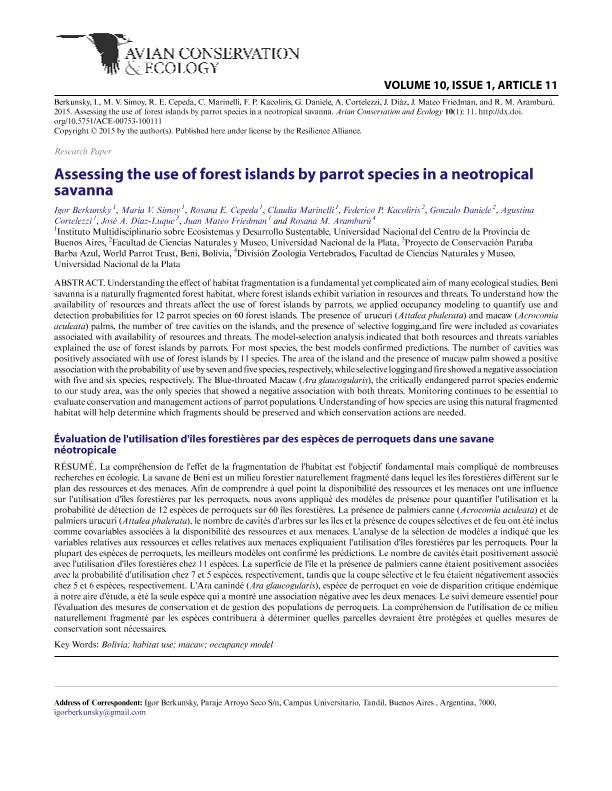Mostrar el registro sencillo del ítem
dc.contributor.author
Berkunsky, Igor

dc.contributor.author
Simoy, Maria Veronica

dc.contributor.author
Cepeda, Rosana Esther

dc.contributor.author
Marinelli, Claudia Beatriz

dc.contributor.author
Kacoliris, Federico Pablo

dc.contributor.author
Daniele, Gonzalo
dc.contributor.author
Cortelezzi, Agustina

dc.contributor.author
Díaz-Luque, José A.
dc.contributor.author
Friedman, Juan Mateo
dc.contributor.author
Aramburu, Rosana Mariel

dc.date.available
2018-08-01T16:15:32Z
dc.date.issued
2015-07
dc.identifier.citation
Berkunsky, Igor; Simoy, Maria Veronica; Cepeda, Rosana Esther; Marinelli, Claudia Beatriz; Kacoliris, Federico Pablo; et al.; Assessing the use of forest islands by parrot species in a neotropical savanna; Resilience Alliance Publications; Avian Conservation and Ecology; 10; 1; 7-2015; 11-11
dc.identifier.issn
1712-6568
dc.identifier.uri
http://hdl.handle.net/11336/53750
dc.description.abstract
Understanding the effect of habitat fragmentation is a fundamental yet complicated aim of many ecological studies. Beni savanna is a naturally fragmented forest habitat, where forest islands exhibit variation in resources and threats. To understand how the availability of resources and threats affect the use of forest islands by parrots, we applied occupancy modeling to quantify use and detection probabilities for 12 parrot species on 60 forest islands. The presence of urucuri (Attaleaphalerata) and macaw (Acrocomia aculeata) palms, the number of tree cavities on the islands, and the presence of selective logging,and fire were included as covariates associated with availability of resources and threats. The model-selection analysis indicated that both resources and threats variables explained the use of forest islands by parrots. For most species, the best models confirmed predictions. The number of cavities was positively associated with use of forest islands by 11 species. The area of the island and the presence of macaw palm showed a positive association with the probability of use by seven and five species, respectively, while selective logging and fire showed a negative association with five and six species, respectively. The Blue-throated Macaw (Ara glaucogularis), the critically endangered parrot species endemic to our study area, was the only species that showed a negative association with both threats. Monitoring continues to be essential to evaluate conservation and management actions of parrot populations. Understanding of how species are using this natural fragmented habitat will help determine which fragments should be preserved and which conservation actions are needed.
dc.format
application/pdf
dc.language.iso
fra
dc.publisher
Resilience Alliance Publications
dc.rights
info:eu-repo/semantics/openAccess
dc.rights.uri
https://creativecommons.org/licenses/by-nc-sa/2.5/ar/
dc.subject
Bolivia
dc.subject
Habitat Use
dc.subject
Macaw
dc.subject
Occupancy Model
dc.subject.classification
Otras Ciencias Biológicas

dc.subject.classification
Ciencias Biológicas

dc.subject.classification
CIENCIAS NATURALES Y EXACTAS

dc.title
Assessing the use of forest islands by parrot species in a neotropical savanna
dc.title
Évaluation de l'utilisation d'îles forestières par des espèces de perroquets dans une savane néotropicale
dc.type
info:eu-repo/semantics/article
dc.type
info:ar-repo/semantics/artículo
dc.type
info:eu-repo/semantics/publishedVersion
dc.date.updated
2018-08-01T14:19:48Z
dc.journal.volume
10
dc.journal.number
1
dc.journal.pagination
11-11
dc.journal.pais
Canadá

dc.description.fil
Fil: Berkunsky, Igor. Consejo Nacional de Investigaciones Científicas y Técnicas; Argentina. Universidad Nacional del Centro de la Provincia de Buenos Aires. Facultad de Ciencias Exactas. Instituto Multidisciplinario de Ecosistemas y Desarrollo Sustentable; Argentina
dc.description.fil
Fil: Simoy, Maria Veronica. Consejo Nacional de Investigaciones Científicas y Técnicas; Argentina. Universidad Nacional del Centro de la Provincia de Buenos Aires. Facultad de Ciencias Exactas. Instituto Multidisciplinario de Ecosistemas y Desarrollo Sustentable; Argentina
dc.description.fil
Fil: Cepeda, Rosana Esther. Universidad Nacional del Centro de la Provincia de Buenos Aires. Facultad de Ciencias Exactas. Instituto Multidisciplinario de Ecosistemas y Desarrollo Sustentable; Argentina
dc.description.fil
Fil: Marinelli, Claudia Beatriz. Universidad Nacional del Centro de la Provincia de Buenos Aires. Facultad de Ciencias Exactas. Instituto Multidisciplinario de Ecosistemas y Desarrollo Sustentable; Argentina
dc.description.fil
Fil: Kacoliris, Federico Pablo. Consejo Nacional de Investigaciones Científicas y Técnicas; Argentina. Universidad Nacional de La Plata. Facultad de Ciencias Naturales y Museo; Argentina
dc.description.fil
Fil: Daniele, Gonzalo. Universidad Nacional de La Plata. Facultad de Ciencias Naturales y Museo; Argentina
dc.description.fil
Fil: Cortelezzi, Agustina. Consejo Nacional de Investigaciones Científicas y Técnicas; Argentina. Universidad Nacional del Centro de la Provincia de Buenos Aires. Facultad de Ciencias Exactas. Instituto Multidisciplinario de Ecosistemas y Desarrollo Sustentable; Argentina
dc.description.fil
Fil: Díaz-Luque, José A.. World Parrot Trust; Bolivia
dc.description.fil
Fil: Friedman, Juan Mateo. Universidad Nacional del Centro de la Provincia de Buenos Aires. Facultad de Ciencias Exactas. Instituto Multidisciplinario de Ecosistemas y Desarrollo Sustentable; Argentina
dc.description.fil
Fil: Aramburu, Rosana Mariel. Universidad Nacional de la Plata. Facultad de Ciencias Naturales y Museo. Departamento Científico Zoología Vertebrados; Argentina
dc.journal.title
Avian Conservation and Ecology
dc.relation.alternativeid
info:eu-repo/semantics/altIdentifier/doi/https://dx.doi.org/10.5751/ACE-00753-100111
dc.relation.alternativeid
info:eu-repo/semantics/altIdentifier/url/http://www.ace-eco.org/vol10/iss1/art11/
Archivos asociados
